
|
Between 1905 and 1910 the interurban station moved from the Wagner Block at East Erie and Broadway to a wood frame building at 113 West Erie Ave. (later renumbered 201 West Erie.) The storefront housed the ticket office and waiting room while the rear of the building served the package agency. The station was again shared with the Cleveland Southwestern whose track approached from the south on Reid Ave. and met the Lake Shore mainline at the station wye. In 1914 the LSE aquired the former Charles James saloon at 121 West Erie, on the opposite side of the station wye, with the intent of building a large, modern interurban terminal in Lorain. The plan called for a freight and express depot on one side of the wye and a spacious two story passenger depot on the other. The ticket office and waiting room would comprise the lower floor with offices and an employee "club room" on the second. Whether for lack of funds or difficulties aquiring additional property, the plan stalled and the former saloon building remained vacant for several years. By 1923 plans were apparently scaled back significantly. The passenger facilities moved to the old saloon building where the waiting room was shared first with a cigar shop and later with a news stand. Whether this was an attempt to bring in a little extra money by renting space to businesses or simply a way to make the waiting room more inviting and hospitable to passengers is uncertain. The front half of the old station was torn down but the package depot at the rear was enlarged with a concrete block addition to accommodate the expanding freight business. A billboard painted on the north wall of the building advertised the Lake Shore's "fast freight service to all important points" in Ohio and surrounding states. The depot remained in regular use for the next fourteen years as freight helped keep the LSE afloat through the lean years, but finally came to an end in 1937. The last wood portion of the building was torn down but the concrete block addition remained, possibly used for storage. With the end of the LSE in 1938 the passenger station shifted to the Lake Shore Coach Company bus line. It was short lived, however. By 1940 both the passenger and freight stations had been demolished, like so many other interurban locations, to make room for automobile parking. Evidence of the station wye remained visible until 1980 when the entire block, including the once popular Heilman's restaurant, was razed for the construction of government offices. The Lorain Tornado On the afternoon of June 28, 1924 the deadliest tornado in Ohio's history swept in from the lake and devastated the city of Lorain. Two LSE local cars, one on West Erie and another on Colorado Ave., were thrown from their tracks, electrical lines and poles were wiped out, and interurban service was crippled for a week. Crews from the Cleveland Railway and the Cleveland Southwestern helped repair the damage and restore service. The tornado also destroyed the dance hall at Glen's Beach which went out of business without attempting to rebuild. The Wagner block, home of the first interurban station, was severely damaged. It was demolished and replaced by the Broadway Building in 1925. Tornado damage was the beginning of the end for two LSE routes. Service on the forlorn East Erie local route was replaced by a bus in 1925, and the Avon Beach & Southern division was sold to the Cleveland Electric Illuminating Company the same year. Downtown To City Limits Just west of the station, at Oberlin Ave. and Second Street, stood the Ohio Public Service Company's Edgewater power plant. Built between 1919 and 1922, the Edgewater plant provided power for the interurbans in downtown Lorain. A substation for the LSE, known as the "North Lorain" substation, was located inside Ohio Public Service "plant 2" at Hamilton Ave. and First Street. Ohio Public Service was a subsidiary of the Cities Service Company, which also became the parent company of the Lake Shore Electric Railway in 1927. When the Beach Park powerhouse was destroyed by fire in 1925 power was purchased from the Edgewater plant until the CEI power plant in Avon Lake was completed. In 2002 the Edgewater plant was decommissioned and demolition began in 2010. Interurbans ran non-stop from downtown to the west city limits, which were then at Leavitt Road. Here the tracks moved off-street to the north side of the road and reverted to a single-track mainline. A passing siding was located here between Leavitt Road and stop 103 at Nichols Street. Oddly this siding was officially referred to as the "water works" siding, despite the actual water works being located a half mile west. An electrical substation was built here in 1920, supplying power to the interurbans until 1925 and commercial electricity after that. In 1932 its electrical equipment was removed and the empty building was used for storage. The substation is now gone but the vacant site is still owned by the Ohio Edison Company. A wye track was located next to the substation and extended 600 feet to the north. (Today only 400 feet of land exists between this site and the lake, the rest having been eroded by Lake Erie's waves.) Here eastbound freight trains would be broken down to the length required for traveling through the city's streets - a freight motor and two trailers. Westbound cars would be coupled together into longer trains before moving on. Trailers were shuttled two at a time between this siding and Beach Park, usually by freight motor 33. At various times, especially when passenger traffic west of Lorain dropped to nearly non-existent levels, Cleveland to Lorain limiteds would run to this stop, turn on the wye, then return to the Lorain station. Continuing beyond the old city limits West Erie Ave. was again called Lake Road, and the LSE passed several other notable locations along its course. The "Castle-on-the-Lake" was built as a residence in 1925, was converted to a supper club in the 1940's, and is now a restaurant. The Lorain Coliseum, just past stop 103, was built in 1926 by the Lorain Moose Lodge, and was sometimes called the Moose Coliseum. Its large, oppulent hall hosted dances, concerts, and roller skating until it was destroyed by a fire in 1952. Today Chris' Restaurant and the Erieview Motel are located on the site. |

way and the Cleveland, Elyria and Western. (Dennis Lamont) |
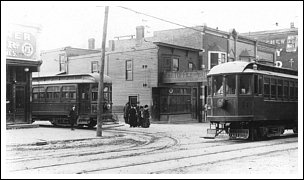
left would become the third station in 1923. (Leiler photo) |
|
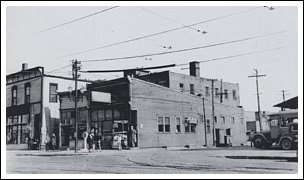
at the freight depot next door. (Dennis Lamont) |
|
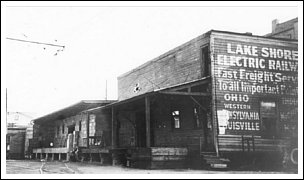
mained after the front office was demolished. (Dennis Lamont) |
|
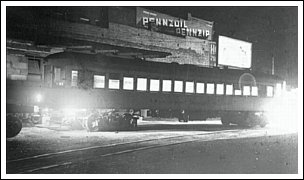
Front of depot has already been demolished. (Dennis Lamont) |
|
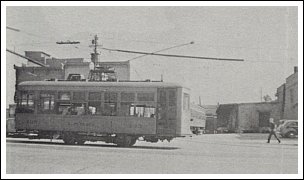
been torn down after end of freight ops. (Harry Christiansen) |
|

the station in 1937. (Harry Christiansen) |
|
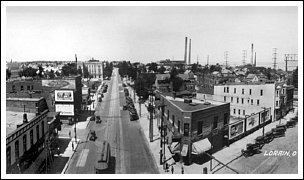
Passenger and freight stations are at left. (Dennis Lamont) |

interurban station is at left, Antler's hotel in background. (Ray Ewers) |

Passengers and crew survived. (Ohio Historical Society) |

damaged by the tornado and was not rebuilt. (Dennis Lamont) |
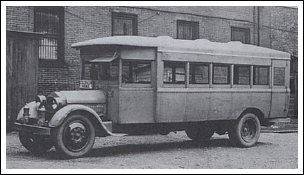
service on East Erie after the tornado. (John A. Rehor) |
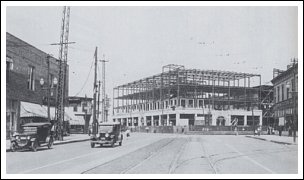
replaced the Wagner Block. (Black River Historical Society) |
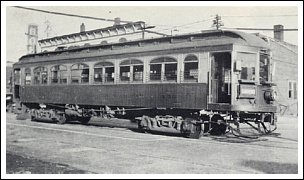
in the late 1930's. (W.R. Miller photo) |

the Oberlin Ave. local route. (Harry Christiansen) |
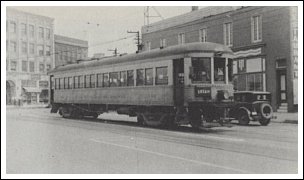
behind, Broadway building at left. (Harry Christiansen) |
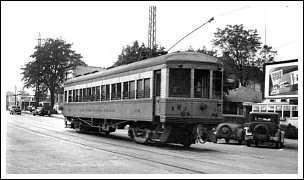
comfort station at right. (Dennis Lamont) |

(Black River Historical Society) |
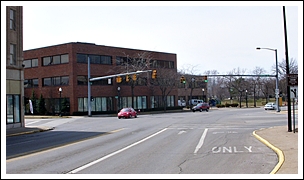
in 1980 and 1986. (Drew Penfield photo) |
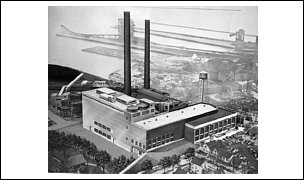
the same parent company as, the LSE. (Drew Penfield) |
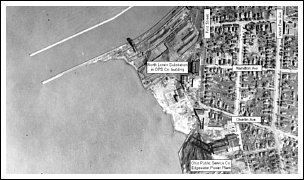
the North Lorain substation. (Dennis Lamont) |
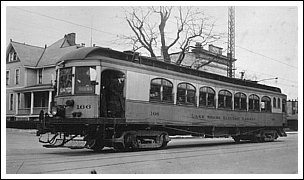
chartered railfan trip in 1938. (Dennis Lamont) |
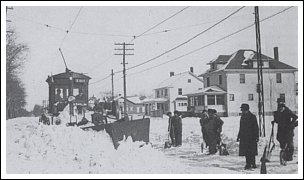
Erie Ave. in 1922. (W.A. McCaleb) |

billboards at left. (George Krambles) |
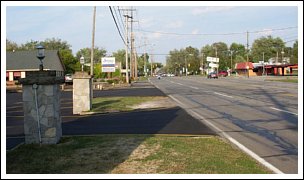
trees just behind restaurant at left. (Drew Penfield photo) |
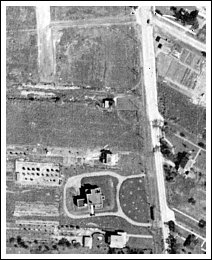
and "castle-on-the-lake." (Dennis Lamont) |
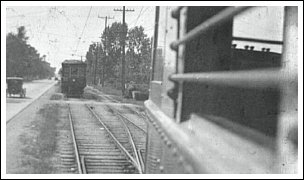
Rd. Eastbound car waits on the siding. (Dennis Lamont) |

at the "water works" siding. (Dennis Lamont) |

passing siding at stop 103. (Dennis Lamont) |

while a supper club in the 40's and 50's. (Dan Brady) |

was a regular stop for local LSE riders. (Dan Brady) |
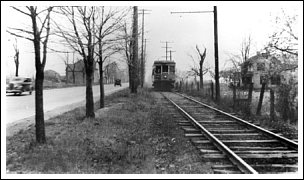
(Ralph A. Perkin photo) |
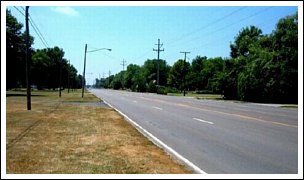
(Dennis Lamont photo) |
|
|
|